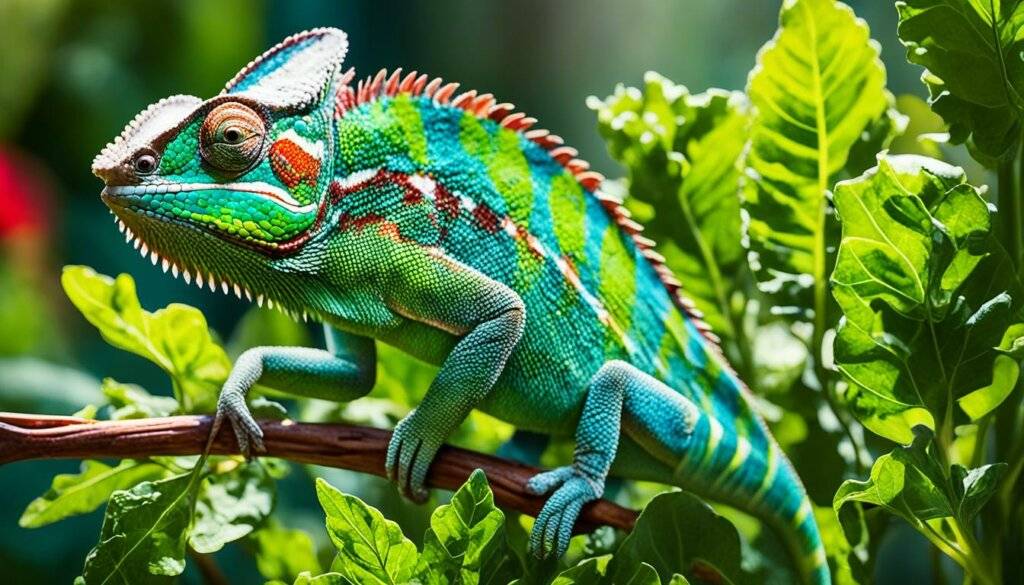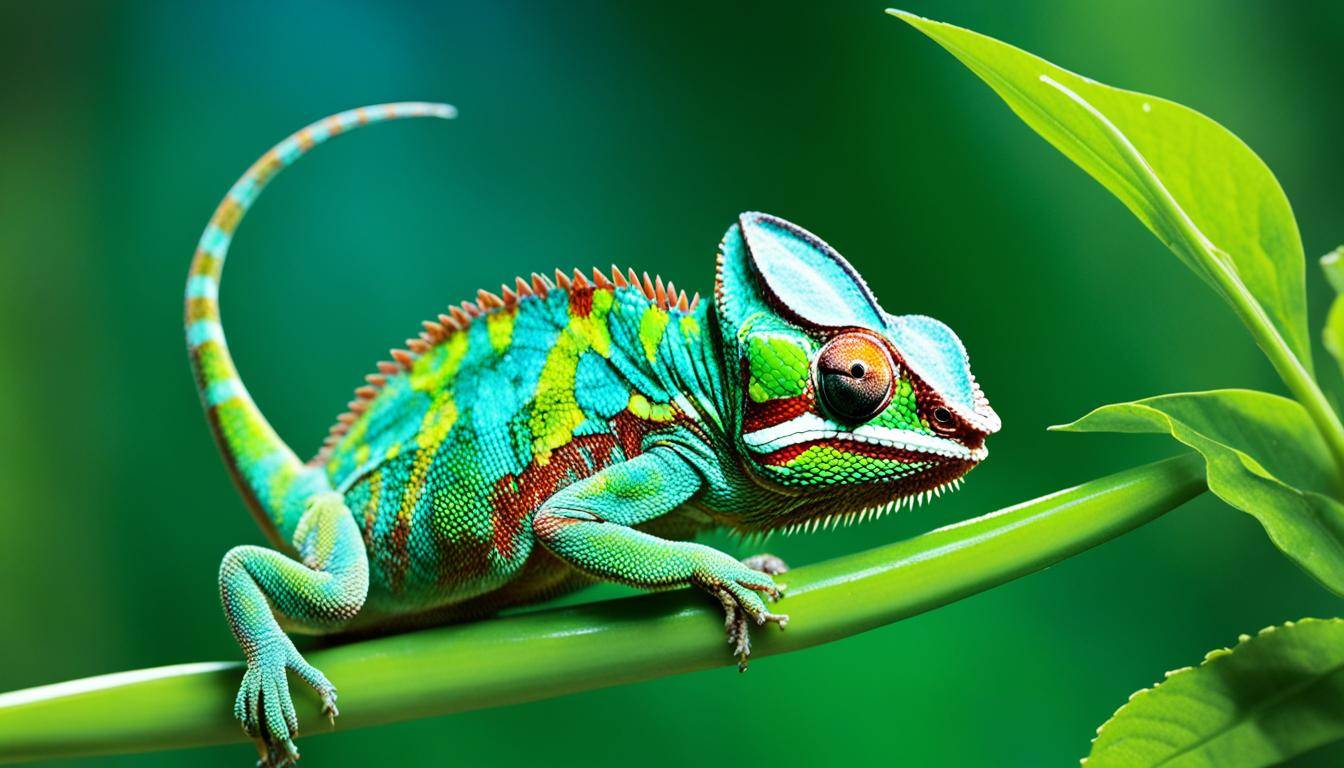Walking through a dense jungle, you spot a flash of colors. A beautiful chameleon is perched on a branch. It captivates you with its color-changing trick. But have you ever asked yourself what these creatures eat?
Chameleons have unique dietary needs for their health. Giving them a balanced diet is crucial for their well-being. In this guide, we’ll go through what chameleons eat. We’ll also show you how to set up their home for healthy eating habits.
We’ll uncover the secrets of a chameleon’s diet. This includes the specific insects they eat and the greens they sometimes nibble on. We’ll also talk about the right temperature and light for them. Plus, tips for keeping their feeding schedule in check and their health good.
If you have a chameleon or are thinking of getting one, this guide is for you. It will give you the info and tools needed to care for them well. Let’s start this feeding journey and find out more about what chameleons eat!
Chameleon Habitat Setup for Optimal Feeding
Making a good home for your chameleon is key for its health. The right space helps your chameleon eat well and stay lively.
Keep your chameleon in a place all its own, like a ventilated terrarium. It helps you manage the warmth and moistness. This is perfect for your chameleon’s happiness and how well it eats.
Add rocks, sticks, and real plants to their home. Chameleons love to climb and check out new spots. These things help keep them active and act like they would in the wild.
| Chameleon Habitat Requirements | Optimal Conditions |
|---|---|
| Temperature | 70-85°F (21-29°C) |
| Humidity | 50-70% |
| Lighting | 12-hour light/dark cycle with UVA/UVB fluorescent bulb |
| Space | Vertical enclosure with at least 18x18x36 inches |
Getting the right heat and moistness is a must. Use special tools to watch the warmth and wetness in your chameleon’s home. This helps your chameleon digest food well and be happy.
Tip: Don’t put your chameleon’s house in windy spots or in the sun. Also, keep it away from big temperature changes.
A good chameleon home helps it eat right and be well in body and mind. With the perfect home set up, it’s time to learn about keeping the temperature and light just right for your chameleon.
Temperature and Lighting Requirements for Chameleons
It’s key to set the right environment for your chameleon’s health. Temperature and light are major factors for their growth and behavior. Here’s a guide on how to keep the right temperature and light for your chameleon:
The Ideal Temperature Range
Chameleons need outside heat to keep their bodies warm. Make sure there are both cool and warm spots in their home. They choose where to be to stay comfortable.
The cool side should be 70-80°F (21-27°C). The warm side could be 80-85°F (27-29°C) or 90-100°F (32-38°C), depending on the type of chameleon. Right temperatures are crucial for their health and digestion.
Lighting for Chameleon Health
Good lighting is vital for chameleons to be healthy. They should have 12 hours of light and 12 hours of dark to copy their wild life. Use a UVA/UVB bulb so they get the right light for making vitamin D3 and having strong bones.
They also need natural sunlight. But, make sure there are shade spots to stop them getting too hot. Watch the light levels to keep them healthy.
Temperature and Lighting Monitoring
It’s important to often check the temperature and light for your chameleon. Use a thermometer to see the various temperatures in their spots. A thermometer with many probes can help you get a good look at the heat in the whole area.
Also, use a hygrometer to watch the humidity. Chameleons need the right dampness for their type.
Expert Tip: Keep light and heat sources away from where your chameleon sits. This stops them from getting too hot or being hurt by the light. Put them to the side for safer and better light and heat.
Creating the Optimal Chameleon Habitat
For your chameleon’s home, add strong branches and rocks to climb. A terrarium with many levels gives them spots to bask at the right temperature.
Place the lights and heat sources well so they’re safe for your chameleon.
You now know how important it is to get the right temperature and light for your chameleon. This helps you make an area where they can live well and be happy.

-
Save
What Insects Do Chameleons Eat?
Chameleons love eating insects for their meals. They eat a wide range of bug types to stay healthy. For instance, they enjoy crickets, dubia roaches, black soldier fly larvae, and superworms.
It’s vital to give chameleons the right kind of food. Dusting their insects with a calcium supplement is a good practice. This keeps their calcium levels in check, which is important for their health.
Aside from regular insects, it’s good to mix in some special ones like hornworms and waxworms. These special treats can add fun to their meals. You can give these during playtime or as a reward.
Chameleons amaze us with their ability to hide and their special eating habits help them do this.
The Importance of a Varied Diet
For chameleons’ health, a diverse diet is a must. Every insect type brings different health benefits. A mix of bugs makes sure the chameleon gets all the vitamins and minerals they need. Plus, it makes their meals more exciting.
Nutritional Considerations
Picking the right insects for your chameleon matters a lot. Crickets and dubia roaches are great choices because they’re nutrient-packed. Yet, save the less nutritional hornworms and waxworms for now and then.
Keep an eye on your chameleon’s eating habits and health. If they seem unwell or not interested in food, it’s best to seek help from a reptile vet. They can give advice on how to improve the chameleon’s diet.
Adding Greens to the Chameleon’s Diet
Vailed chameleons love a mix of bugs and greens. Bugs give them important protein and nutrients. The right greens add extra health benefits for your chameleon.
Collard greens and mustard greens work well for chameleons. They’re full of vitamins and minerals, helping keep their diet in balance.
Giving greens is good, but not too much. Too many greens can trouble their tummy. The best idea is to let them eat greens once a day and only for a few hours.
Take the leftover greens out after four hours. This keeps their food from going bad and their area clean. Since chameleons picky, they might like one green more than another.
Always wash the greens before feeding. This gets rid of pesticides or other things that could harm them. Safe, clean greens are key to a healthy chameleon.
Benefits of Adding Greens to Your Chameleon’s Diet
Adding greens to your chameleon’s diet has many pluses:
- Greens carry a lot of vitamins and minerals. They help your chameleon grow and stay healthy.
- The high water in greens keeps your chameleon hydrated. This is crucial as they drink from droplets.
- Fiber in greens helps their stomach work well. It stops constipation and makes their digestion better.
- A variety of food, including greens, keeps them happy and healthy. It stops them from getting bored and prevents diet problems.
“Adding appropriate greens to your chameleon’s diet is a great way to enhance their nutritional intake and support their overall health.”
Greens make your chameleon’s diet better and more nutritious. Always check with a reptile expert or vet. They can help you pick the best greens for your chameleon’s type.
Now, let’s look at when and how much to feed your chameleon. And their water needs too, for the best health.

-
Save
Feeding Schedule and Hydration for Chameleons
To care for chameleons well, it’s important to set up a feeding plan and make sure they drink enough. This way, you help them stay healthy and happy. Knowing what they need is key.
Feeding Schedule
Chameleon eating times depend on how old they are. You need to think about their size and what nutrients they need. Here’s the schedule you should follow:
- Baby chameleons should eat twice a day.
- Juvenile chameleons need food once daily.
- Adult chameleons can eat every other day.
Tip: Don’t give your chameleon too much food. It’s important to clear away any uneaten food to keep their home clean.
Hydration
Chameleons drink from water droplets. To keep your pet well-hydrated, spray the cage with water a few times each day. You can also set up a dripper to mimic rain for a natural way of drinking.
Keeping your chameleon well-hydrated is critical for its health. Look for signs like sunken eyes or dry skin, which mean it’s thirsty. If you see this, step up the misting or adjust the dripper to make sure it has enough water.
Always use clean, chlorine-free water when spraying or dripping water. This keeps your chameleon safe and healthy.
Maintaining Chameleon Health
Taking care of your chameleon’s health is key to its happiness and long life. There are important tips to follow. These help make a great home for your pet.
Post-Acquisition Care
When you get your chameleon, let it get used to its new home without picking it up. This break from handling helps reduce stress.
Always watch for health signals. Changes in droppings, less eating, or swelling are signs something’s wrong. If you see these, go to a vet for advice.
Diet and Nutrition
Chameleons need insects for their main food. Make sure these insects are nourished with good food. Also, add a calcium powder to their meals.
Healthy eating keeps them strong and ward off sickness. It helps them stay at a good weight.
Environment and Husbandry
A good living space is vital for chameleons. Their home should be the right warmth and dampness. Bad weather can harm them.
Keep their house clean to avoid sickness. Also, set up enough room for them to move and rest. A stress-free home makes a happy chameleon.
Chameleons need the right light to use calcium well. Check and change their UVB light as needed. This keeps their bones healthy.
| Guidelines to Maintain Chameleon Health |
|---|
| Avoid handling your chameleon for a few days after bringing them home to reduce stress. |
| Watch for signs of illness, such as runny droppings, decreased appetite, and discharge from the eyes, nose, or mouth. Consult a veterinarian if symptoms occur. |
| Feed your chameleon a high-quality diet consisting primarily of insects and supplemented with calcium. |
| Maintain the optimal temperature and humidity levels within their enclosure. |
| Regularly clean their habitat and provide ample space for exercise and basking. |
| Ensure your chameleon has access to proper UVB lighting for calcium metabolism. |
Following these key points will keep your chameleon healthy and happy. If you’re concerned about its health, talk to a reptile vet right away.
Conclusion
It’s crucial to give chameleons a varied and healthy diet for them to live long and well. They mostly eat insects for the protein and nutrients they need.
But, chameleons can also eat greens and some fruits. These will give them extra vitamins and minerals. Just don’t give them too much fruit to avoid stomach problems.
Setting up the right home is also key for a chameleon’s mealtime happiness. Make sure their space feels like their natural habitat. Add places for them to climb and hide.
Having a feeding plan, checking on their health, and making the perfect home for them are crucial. With this, your chameleon can be a happy and healthy friend. A well-cared-for chameleon is a joy to have!
